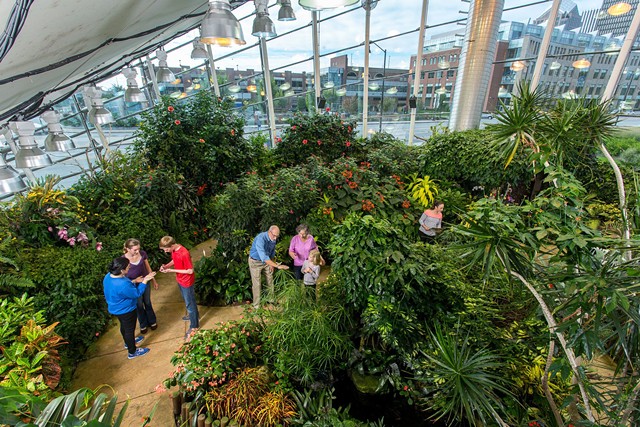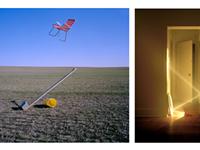Tropical paradises: these indoor hot spots will keep you warm this winter
By Rebecca Rafferty @rsrafferty[
{
"name": "500x250 Ad",
"insertPoint": "5",
"component": "15667920",
"parentWrapperClass": "",
"requiredCountToDisplay": "1"
}
]
EDITOR'S NOTE: This article has been updated to reflect a change in dates for George Eastman' Museum's Dutch Connection exhibit, which is delayed one week due to the COVID surge.
There’s a Japanese concept called shinrin-yoku that translates in English to mean “forest bathing,” or “taking in the forest atmosphere.” The general idea is that periodically immersing oneself in nature has its benefits, physically and spiritually.
Missing from the exercise this time of year, of course, are those dazzling shades of green and the golden warmth that relax the body and mind. While the cold can be invigorating and pretty, it doesn’t evoke visions of paradise.
But there are a few oases-like spaces around town that simulate the forest — or jungle, or garden — environment in the middle of the winter. Experience colorful blooms, humidity, and signs of life right now.
BUTTERFLIES, TURTLES, AND WEE BIRDS, OH MY!
The first time I visited The Strong National Museum of Play’s Dancing Wings Butterfly Garden, it was a mid-winter day almost a decade ago, and I recall feeling transported from the gross, slushy sidewalks of downtown to a rainforest retreat.
The gray skies outside melted away behind the towering greenery climbing the windowed walls of the 1,800-square foot garden and the condensation caused by the high humidity running down the glass.
“The environment is meant to replicate Costa Rica, or the southern tip of Florida,” says Anna Becker-Simpson, supervisor of life collections at The Strong.
The temperature is kept between 75 and 80 degrees to make the tropical species of butterflies — the vibrant blue morphos, the paper kites, and the disguise-master owl butterfly — feel at home. But it offers the perfect respite from the frigid winter for people, too.
While trying to spot the hundreds of butterflies that dwell in the garden on any given day, look up and around at the lush greenery. Footpaths guide visitors through trees and ferns that provide nectar for the butterflies, which have been known to alight on the gentlest of visitors.
But tread carefully. Sharing the paths are turtles, button quail, and a tortoise, which are all part of the ecosystem, meaning the clean-up crew for any expired butterflies. A chameleon is on site in a sequestered enclosure, and there’s a wall-mounted case filled with various jewel-like, live crysali, the transformative pod stage between caterpillar and butterfly (for those who need to brush up on elementary science).
“It's just a great chance to warm up and enjoy a piece of nature that we don't get to see this time of year, especially in the Rochester area,” Becker-Simpson says. “You know, you got these big lamps overhead that are putting out sunlight, essentially. . . . And this gives people a chance to get back to nature, even when nature is currently a little…arctic.”
Admission to the Dancing Wings Butterfly Gardens costs $24 for ages 2 and up, is free to kids under 2, and is $4 for museum members. The capacity is limited to 40 people.
A MANSION FILLED WITH FLOWERS
One of the best things about museums is the casual access they offer to the art and cultural collections of the dead elite — and in some special cases, their homes. An obvious local example is the George Eastman Museum, which showcases not only the institution’s vast and beautifully curated collection of photographic and film ephemera but also the historic mansion and its grounds.
You can access the museum year-round, but there are certain times when the staff replicates how Eastman lived in his day. Each February, for instance, spring comes early as parts of the mansion are filled with scores of potted tulips, hyacinths, daffodils, amaryllis, freesias, and other blossoms during the annual “Dutch Connection” special event.
Its vibrant hues and heady scents are a feast for the senses. Long before it became fashionable to turn your living quarters into a jungle of houseplants, Eastman understood the benefits of surrounding yourself with growing plants in the middle of winter.
The museum explains that between 1905 and his death in 1932, Eastman ordered tens of thousands of bulbs from Holland every year. Inspired by the extensive fields of colorful flowers he noted from his bicycle while on a trip to Holland in 1895, he ordered tulip, narcissus, and hyacinth bulbs for indoor forcing and display during the bitter months, as well as tulip bulbs for the outside beds.
Eastman’s Landscape Manager Dan Bellavia, who designs the museum’s display of 67 varieties of plants, has even more to say about the event on an audio tour that can be listened to on site or at home.
“The Dutch Connection, which began in 1995, is a representation of the volume of bulbs George Eastman would have forced and displayed during the whole winter season,” he says. The museum still sources the bulbs from one of the Dutch suppliers that Eastman used.
The Dutch Connection will be displayed Feb. 12-March 6, accessible during museum hours with the purchase of a ticket. Vaccinations are required to visit the museum. When you visit, you can buy tulip, hyacinth, daffodil, and other bulbs, and the museum has a handy set of video and PDF tutorials for planting them.
THE GLASS HOUSE OF GREENERY
The lush environments inside the different rooms of Lamberton Conservatory can be enjoyed year round, but it’s a treat to spend time there in the months that outdoor greenery is buried under blankets of snow. It’s a veritable oasis of warmth and life in the midst of a city in its grayscale months.
The ornate greenhouse at Highland Park is now more than 110 years old. Built in 1911 in the renowned arboretum designed by Frederic Law Olmstead, the conservatory is named for Alexander B. Lamberton, who served as president of the Monroe County parks board from 1902 to 1915. It was taken apart and rebuilt in 2007 for a complete restoration.
The space has hundreds of plant species growing from the ground, suspended from above, and in clusters of pots on tables that line the walls. An arid room boasts towering cacti and a monstrous agave plant. You’ll pass through curtains of Spanish moss, and catch sight of the fleet-footed button quail scurrying underfoot. There’s an outdoor koi pond in the central courtyard where curious fish will nibble at your fingers.
You can rest on one of the many benches set up around the spot, and watch the turtles sunning themselves on logs in the streams and pools that run along the footpaths. Some days, artists occupy those benches, rendering the plants with pencil or watercolors in sketchbooks. Sitting or strolling at Lamberton always makes me feel like I’m in a Miyazaki film.
The 1,800-square foot space can be booked for special events, but it’s also a highly accessible place for all ages to experience some warmth and tranquility. Admission is $3, $2 for seniors, and free to kids 5 and younger.
Rebecca Rafferty is CITY's life editor. She can be reached at [email protected].
There’s a Japanese concept called shinrin-yoku that translates in English to mean “forest bathing,” or “taking in the forest atmosphere.” The general idea is that periodically immersing oneself in nature has its benefits, physically and spiritually.
Missing from the exercise this time of year, of course, are those dazzling shades of green and the golden warmth that relax the body and mind. While the cold can be invigorating and pretty, it doesn’t evoke visions of paradise.
But there are a few oases-like spaces around town that simulate the forest — or jungle, or garden — environment in the middle of the winter. Experience colorful blooms, humidity, and signs of life right now.
BUTTERFLIES, TURTLES, AND WEE BIRDS, OH MY!
The first time I visited The Strong National Museum of Play’s Dancing Wings Butterfly Garden, it was a mid-winter day almost a decade ago, and I recall feeling transported from the gross, slushy sidewalks of downtown to a rainforest retreat.
The gray skies outside melted away behind the towering greenery climbing the windowed walls of the 1,800-square foot garden and the condensation caused by the high humidity running down the glass.
“The environment is meant to replicate Costa Rica, or the southern tip of Florida,” says Anna Becker-Simpson, supervisor of life collections at The Strong.
The temperature is kept between 75 and 80 degrees to make the tropical species of butterflies — the vibrant blue morphos, the paper kites, and the disguise-master owl butterfly — feel at home. But it offers the perfect respite from the frigid winter for people, too.
While trying to spot the hundreds of butterflies that dwell in the garden on any given day, look up and around at the lush greenery. Footpaths guide visitors through trees and ferns that provide nectar for the butterflies, which have been known to alight on the gentlest of visitors.
But tread carefully. Sharing the paths are turtles, button quail, and a tortoise, which are all part of the ecosystem, meaning the clean-up crew for any expired butterflies. A chameleon is on site in a sequestered enclosure, and there’s a wall-mounted case filled with various jewel-like, live crysali, the transformative pod stage between caterpillar and butterfly (for those who need to brush up on elementary science).
“It's just a great chance to warm up and enjoy a piece of nature that we don't get to see this time of year, especially in the Rochester area,” Becker-Simpson says. “You know, you got these big lamps overhead that are putting out sunlight, essentially. . . . And this gives people a chance to get back to nature, even when nature is currently a little…arctic.”
Admission to the Dancing Wings Butterfly Gardens costs $24 for ages 2 and up, is free to kids under 2, and is $4 for museum members. The capacity is limited to 40 people.
A MANSION FILLED WITH FLOWERS
One of the best things about museums is the casual access they offer to the art and cultural collections of the dead elite — and in some special cases, their homes. An obvious local example is the George Eastman Museum, which showcases not only the institution’s vast and beautifully curated collection of photographic and film ephemera but also the historic mansion and its grounds.
You can access the museum year-round, but there are certain times when the staff replicates how Eastman lived in his day. Each February, for instance, spring comes early as parts of the mansion are filled with scores of potted tulips, hyacinths, daffodils, amaryllis, freesias, and other blossoms during the annual “Dutch Connection” special event.
Its vibrant hues and heady scents are a feast for the senses. Long before it became fashionable to turn your living quarters into a jungle of houseplants, Eastman understood the benefits of surrounding yourself with growing plants in the middle of winter.
The museum explains that between 1905 and his death in 1932, Eastman ordered tens of thousands of bulbs from Holland every year. Inspired by the extensive fields of colorful flowers he noted from his bicycle while on a trip to Holland in 1895, he ordered tulip, narcissus, and hyacinth bulbs for indoor forcing and display during the bitter months, as well as tulip bulbs for the outside beds.
Eastman’s Landscape Manager Dan Bellavia, who designs the museum’s display of 67 varieties of plants, has even more to say about the event on an audio tour that can be listened to on site or at home.
“The Dutch Connection, which began in 1995, is a representation of the volume of bulbs George Eastman would have forced and displayed during the whole winter season,” he says. The museum still sources the bulbs from one of the Dutch suppliers that Eastman used.
The Dutch Connection will be displayed Feb. 12-March 6, accessible during museum hours with the purchase of a ticket. Vaccinations are required to visit the museum. When you visit, you can buy tulip, hyacinth, daffodil, and other bulbs, and the museum has a handy set of video and PDF tutorials for planting them.
THE GLASS HOUSE OF GREENERY
The lush environments inside the different rooms of Lamberton Conservatory can be enjoyed year round, but it’s a treat to spend time there in the months that outdoor greenery is buried under blankets of snow. It’s a veritable oasis of warmth and life in the midst of a city in its grayscale months.
The ornate greenhouse at Highland Park is now more than 110 years old. Built in 1911 in the renowned arboretum designed by Frederic Law Olmstead, the conservatory is named for Alexander B. Lamberton, who served as president of the Monroe County parks board from 1902 to 1915. It was taken apart and rebuilt in 2007 for a complete restoration.
The space has hundreds of plant species growing from the ground, suspended from above, and in clusters of pots on tables that line the walls. An arid room boasts towering cacti and a monstrous agave plant. You’ll pass through curtains of Spanish moss, and catch sight of the fleet-footed button quail scurrying underfoot. There’s an outdoor koi pond in the central courtyard where curious fish will nibble at your fingers.
You can rest on one of the many benches set up around the spot, and watch the turtles sunning themselves on logs in the streams and pools that run along the footpaths. Some days, artists occupy those benches, rendering the plants with pencil or watercolors in sketchbooks. Sitting or strolling at Lamberton always makes me feel like I’m in a Miyazaki film.
The 1,800-square foot space can be booked for special events, but it’s also a highly accessible place for all ages to experience some warmth and tranquility. Admission is $3, $2 for seniors, and free to kids 5 and younger.
Rebecca Rafferty is CITY's life editor. She can be reached at [email protected].
Speaking of...
Latest in Culture
More by Rebecca Rafferty
-

Beyond folklore
Apr 4, 2024 -

Partnership perks: Public Provisions @ Flour City Bread
Feb 24, 2024 -

Raison d’Art
Feb 19, 2024 - More »










